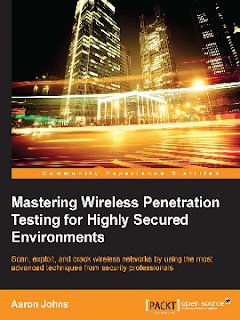Wireless technology has become increasingly popular as it allows you to
easily
access the Internet from all sorts of locations around the world without
requiring
a network cable. But a wireless network isn't always secure if you don't
understand
its dangers, and especially if precautions are not taken. It is important
to secure
your wireless network for your own protection. Instances of identity and
personal
information theft has risen in the last several years.
Even though it is easier to set up and connect to an unsecure wireless
network, it is
no longer safe as there is a greater risk of your personal data being
stolen. It can be
easily intercepted by another user with little to no experience. An
unsecured wireless
network is also another way for a user to monitor your online activity,
such as your
web surfing habits, chats, e-mail, and even your online banking account.
While this book provides methods to protect wireless networks, it focuses heavily on
how an attacker can break into a secured wireless network. It also demonstrates
what an attacker can do once they have access to a wireless network.
What this book covers
Chapter 1, Preparing for an Effective Wireless Penetration Test , gives a brief introduction to wireless penetration testing,
Kali Linux, and wireless cards.
Chapter 2, Wireless Security Testing,
shows you the steps to take during a wireless
penetration test. It also explains examples of wireless attacking techniques and methods.
Chapter 3, Footprinting and Reconnaissance, explains two different types of wireless
scanning and how they are used: sniffing wireless networks for rogue access
points and logging usernames and passwords.Preface[2 ]
Chapter 4, Penetrating Wireless Networks, explains how to plan an attack, crack WEP/WPA/WPA2
wireless networks, and perform MAC spoofing to gain unauthorized
access to the wireless network. You will also learn how to protect yourself
from
these threats.
Chapter 5, Gaining Access to the Network, discusses how to access an unauthorized network,
run an assessment on the network to identify hosts, determine the network size,
and detect vulnerable hosts.
Chapter 6, Vulnerability Assessment, performs
a vulnerability assessment on the network
to determine potential threats on it.
Chapter 7, Client-side Attacks, shows how a hacker can attack systems and other devices on the network. You will also learn
how to protect yourself from
these attacks.
Chapter 8, Data Capture and Exploitation, explains how to capture sensitive information
on unencrypted traffic and how man-in-the-middle attacks work.
Chapter 9, Post-Exploitation, explains how to pivot into the local network to
access other hosts and networks, document their work, and clean up.
Chapter 10, Reporting, explains how to provide a report that contains detailed
information on vulnerabilities during the wireless penetration test. The
summarized
report will provide documentation of the test and how to resolve the
potential threats.
Download Book : http://adf.ly/1ci9eU




0 Commentaires